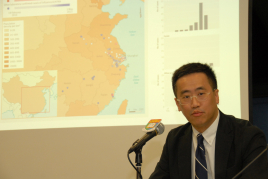Media
Latest research findings on avian influenza A (H7N9) virus from HKU Public Health Research Centre
24 Jun 2013
The University of Hong Kong Li Ka Shing Faculty of Medicine reports the latest round of empirical and other research findings regarding to influenza A (H7N9) virus. Studies analyse the data of human infection with H7N9 virus in mainland China, including comparison with the epidemiologic characteristics of influenza A (H5N1) virus, clinical severity of human infection cases and mild to moderate infections, etc. The result provides significant implications to future pandemic assessment and prevention for H7N9.
Please visit the website at http://www.med.hku.hk/v1/media/1315.pdf for powerpoint presentation.
The University of Hong Kong Li Ka Shing Faculty of Medicine and Chinese Centre for Disease Control and Prevention conducted a collaborative study on the epidemiology of avian influenza A (H7N9) virus.The study finds that H7N9 is not as severe as H5N1, but more severe than 2009 pandemic A (H1N1). (From the left): Dr Dennis Ip Kai-ming, Clinical Assistant Professor; Dr Benjamin J Cowling, Associate Professor; Professor Gabriel M Leung, Director of Public Health Research Centre and Professor and Head of Department of Community Medicine; Dr Joseph T Wu, Associate Professor, Public Health Research Centre and Department of Community Medicine, HKU Li Ka Shing Faculty of Medicine.
Professor Gabriel M Leung, Director of Public Health Research Centre and Professor and Head of Department of Community Medicine, HKU Li Ka Shing Faculty of Medicine says that the seasonal pattern of H5N1 suggests H7N9 might reappear in the autumn. He reminds the community that it is an opportunity to prepare definitive public health measures.
Dr Benjamin J Cowling, Associate Professor, Public Health Research Centre and Department of Community Medicine, HKU Li Ka Shing Faculty of Medicine remarks that researchers conducted an intensive follow-up study of 2500 contacts cases with the infected humans, it turned out only 4 potential secondary infections identified. It is good evidence for low risk for human-to-human transmissibility.
Dr Joseph T Wu, Associate Professor, Public Health Research Centre and Department of Community Medicine, HKU Li Ka Shing Faculty of Medicine analysed 123 hospitalized cases of H7N9. It shows that the risk of fatality for H7N9 hospitalized cases is 36%, which is lower than that of H5N1 (65%) while higher than H1N1 (5%-20%)
Dr Dennis Ip Kai-ming, Clinical Assistant Professor, Public Health Research Centre and Department of Community Medicine, HKU Li Ka Shing Faculty of Medicine is one of the speakers. He is in charge of the study about China’s national sentinel surveillance system for influenza-like illness which is going to be published online in British Medical Journal (BMJ) tomorrow morning.





